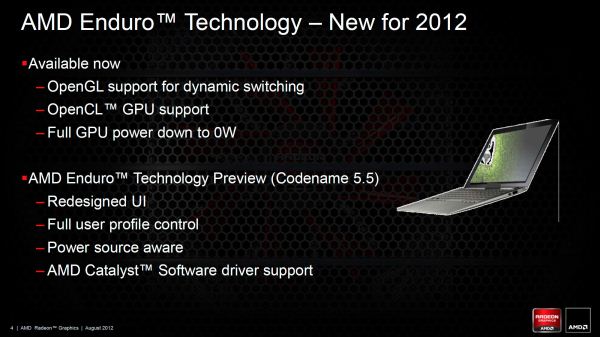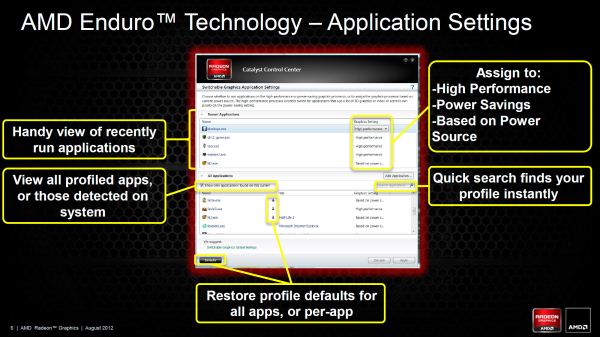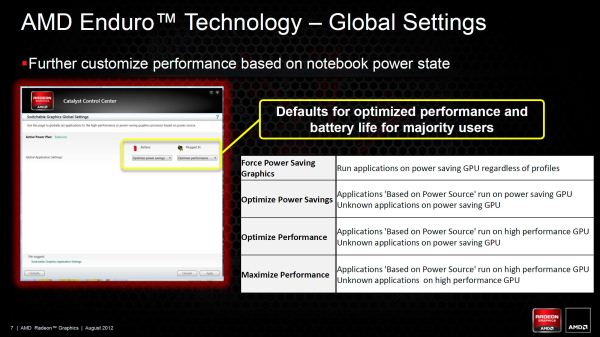AMD’s Enduro Switchable Graphics Levels Up
by Jarred Walton on September 6, 2012 3:00 AM ESTNew for Mid-2012: “Enduro 5.5” Enhancements
When AMD created the Enduro brand, they were really almost where we wanted them. They had dynamic switching with support for most of the latest games and applications, and when it worked properly it would be difficult to tell if you were using an NVIDIA or an AMD dGPU. The problem was when things didn’t work and you had to go into the drivers, and there were several problems. OpenGL support was totally out, many of the latest games were also missing default profiles (and sometimes wouldn’t let you properly specify the correct GPU), the UI was obtrusive and sometimes hard to use (particularly for power users), and the drivers were dictated by the laptop manufacturers and were usually months old at launch and never updated.
While the UI seems like a minor thing to fix—I would have thought one or two months to improve the UI would have been sufficient—at least prior to the forthcoming update it remained largely unchanged. The lack of AMD-provided driver updates was really the major issue, because everything else could potentially be fixed with new drivers and you would never know. The other areas like OpenGL/OpenCL and support for various games/applications should improve over time as well, provided you can get drivers. That brings us to the upcoming Enduro release, scheduled to come out sometime this month or next. Officially it’s still just Enduro, but to help differentiate between the previous Enduro release and the upcoming release we’ll sometimes refer to the new version as “Enduro 5.5”.
The biggest news with the latest iteration of Enduro is that AMD is planning to make universal reference drivers available for all the Enduro laptops. It’s not clear precisely what that means, but potentially any laptop with Dynamic Switchable Graphics or later (e.g. PX4.0 and later) would be supported by AMD’s “reference” drivers. That’s huge, and if AMD can deliver it will assuage most of our concerns with their hardware/software. Hopefully none of the OEMs get bent out of shape or refuse to allow support, which is a problem we've seen in the past. We should see the first public release in the next month or two, and then another release somewhere in the November/December timeframe.
Besides the availability of driver updates, the UI also receives a much needed overhaul, providing both regular and power users all the options they’re likely to need as far as control of graphics switching is concerned. Open up the switchable graphics options and the top section remains largely the same, but the bottom now allows you to see all application profiles (or just the profiles for detected applications). There’s also a quick search option that works both on executable name and application/game name (e.g. HL2.exe or Half-Life 2 will both find the profile for Half-Life 2). From either list (recently used apps up top, or all apps at the bottom), you can set the GPU profile.
Where previously there were two settings (three if you count “Not Assigned”), there are now three options. As before, “Power saving” sets an application to run on the integrated graphics while “High performance” sets an application to run on the discrete GPU. The new third option is “Based on power source”, which does precisely what you’d expect: plug the laptop in and the apps with this setting will run on the discrete GPU; switch to battery power and they’ll run on the integrated graphics. For many users, everything could default to “Based on power source” and they would be happy, but certainly there will be times where you’re running on battery power but still want to use the dGPU and the drivers give you that option. Should things get squirrelly, you can also reset applications individually or globally to their default settings. It’s worth noting that the power state aware setting is something that NVIDIA currently does not implement, requiring manual intervention if you wish to override your normal settings—though how often people are using apps that require the dGPU while on battery power is something we could debate.
Besides the individual application profiles, AMD is also adding a new area to their drivers: Switchable Graphics Global Settings. This is something you could sort of get before with some laptops, but previously it involved changing from Dynamic Switchable Graphics to manual switching (i.e. switching based on power source) and then forcing the laptop into High Performance or Power Saving mode if you wanted to be low power while plugged in or high power while unplugged. That was clunky and at least in the case of the Sony VAIO C we tested it caused flickering similar to the old switchable graphics, with the dGPU drivers getting unloaded and iGPU drivers getting loaded (or vice versa), with some work behind the scenes copying context from one GPU to the other. It worked but it wasn’t elegant; perhaps more importantly, Microsoft doesn’t want anyone doing this with Windows 8 and thus new laptops won’t be able to get a Windows 8 sticker if they use this method of switching (which basically means no new laptops will do this). To make up for the loss of this functionality (which some people still prefer), AMD has added a new global settings section.
Unlike the individual application profiles, the global settings gives you four options each for Battery and Plugged In. The top two options are similar in most cases and will generally run most applications on the iGPU, and the same goes for the bottom two modes where you’ll run most apps on the dGPU. The difference is that “Force Power Saving GPU” will run all applications (regardless of what the custom profile says) on the iGPU, essentially disabling the dGPU completely. “Optimize Power Savings” in contrast will run all unknown or “Based on power source” applications on the iGPU while respecting the application profiles where they exist. “Optimize Performance” is sort of the reverse of that, running all “Based on power source” applications on the dGPU while leaving unknown applications on the iGPU. Finally, the “Maximize Performance” option runs all unknown and “Based on power source” applications on the dGPU—but applications specifically set to use the iGPU will continue to do so.
The reason for that last discrepancy (e.g. why you can’t simply run everything on the dGPU and forget about the iGPU) is that certain tools have to run on the iGPU. Intel’s drivers are one example—loading those up on the dGPU would cause problems. Intel’s WiDi is the only other I could find on my particular Clevo notebook. We were told that some of the laptop utilities like an overlay showing percentage of brightness, volume, etc. may also need to run on the iGPU. Besides the few applications that have to run on the iGPU, any applications that are set to Power Saving will continue to use the iGPU—and this makes sense as there are a lot of applications that can be set to run on iGPU/dGPU that have no need of higher performance GPU options (several anti-virus utilities come to mind, where they're starting to create a 3D context for their UI). The net result is that other than a few specific applications where the profile will exist and be locked to the iGPU, with no option to change to dGPU, everything else that uses higher function graphics can be customized to run on a specific GPU, but if you set something to iGPU presumably you want it to always run there—otherwise you would use the “Based on power source” setting.
A full set of screenshots from all the driver screens is available in the gallery below if you’re interested.
One final topic worth discussing is Windows 8. Certainly there are owners of existing laptops with switchable graphics that are wondering if they can upgrade to Windows 8 and what will happen. We’ll have to see how this actually plays out, but it sounds like the earlier versions of PowerXpress (3.0 and earlier) will probably get support with one driver bundled with Windows 8, and that may be it—but there’s always the possibility for the laptop OEMs to release their own updates, or for AMD to roll out additional drivers for older laptops. The potential for PowerXpress 4.0 and later laptops to get regular driver updates (for Windows Vista/7/8) is there, but until we actually start seeing public driver releases AMD hasn’t fully committed to supporting all of those laptops.



















200 Comments
View All Comments
arcticjoe - Thursday, September 6, 2012 - link
Would be nice if the article reflected a more detailed picture of the problem with AMD's enduro problem - with Enduro enabled 7970m performance is crippled, where is many games you get the same low fps on lowest settings as you do with ultra, so even my 6970m can outperform it and give me much smoother framerates.yes I can get 36fps in BF3, but if I lower my detail settings to low or increase my GPU clocks fps will stay the same, so its difficult to competitively play multiplayer games.
It has now been nearly half a year since I paid £1700 for my top of the range laptop, but after spending literally hundreds of hours on re-installing drivers, windows, messing around with various settings I am now at wits end. Meanwhile AMD have been doing their best to pin the issue on someone else and when cornered with a mountain of evidence they've had a thread with many hours of logged data removed from NBR forum.
As much as I hate other people saying this about any manufacturer, i can confidently say this is the last time I pay for any AMD product. Faulty product, with no support
coder543 - Thursday, September 6, 2012 - link
I've said this for a long time, and I'm going to say it again.If you aren't happy with a product when you buy it, you should return it. You aren't guaranteed to have updates which will fix the issues you're having. The product was sold as-is.
I like AMD, they have good products. Apparently their support for the Clevo with 7970M is a bit lacking, so I wouldn't buy that. It doesn't mean I'm going to boycott all of their products. If I buy something of theirs and it isn't working, I'm not going to sit around and hope it'll get fixed. I may return it and hold off buying a competitor's product for awhile to see if it gets fixed, but you're trying to pin this on AMD.
AMD messed up, but you didn't hold them to it, and so now you're stuck with a bad product. Clevo has a 30 day full refund return policy. If all of the people with these problems would have returned these laptops with the 7970m GPUs, then Clevo would have thrown the boxes of them in AMD's face, saying they want a working product. That's putting your money where your mouth is, but you let Clevo and AMD have your money, which let's them believe you're satisfied.
arcticjoe - Thursday, September 6, 2012 - link
Problem is that being one of the first adopters I was told that this was just a drivers issue and any week now AMD will release some new drivers and fix this problem. Issue was reported to AMD very early and initially they replied with "we are looking into this issue and it will be resolved soon". Since I had no reason to doubt AMDs word or abilities so I stuck with the product. This was 5 months ago, so now I am pretty sure there is a design fault somewhere and the card probably cannot be fixed without a hardware modification.Montage - Thursday, September 6, 2012 - link
Moreover, most people didn't even know there was a problem. They didn¨'t know that they weren't getting what they paid for. Not all games have this issue and the 7970M does perform better than some of the ancient cards people used before getting the 7970M.There is a thing called WARRANTY, that should guarantee you a fully working product at least as long as that warranty lasts (which is 1-2 years, not 30-days...)
transphasic - Sunday, September 9, 2012 - link
Yes, I agree with you, and I DID buy a two year warranty as a precaution against this type of thing, but Sager and the reseller said NO WAY to my request to have my 7970m swapped out for the far better, far more powerful Nvidia 680m.In short, my TWO YEAR warranty will not cover this, and is virtually worthless to me now. What good is a warranty that won't protect my investment?
Vozier - Thursday, September 13, 2012 - link
do you have accident coverage? maybe your laptop can fall down your balcony.... just saying.... and maybe then you can ask for the swap paying the difference? LOL....I still think the 7970 is a good price value option, keep it and next year you might buy the 7990 or an 8000 and spende as much as you will buying a new 680M NOW... so take your calculator and run some numers before deciding.
vgray35@hotmail.com - Thursday, September 6, 2012 - link
Exactly. It takes 2 to 3 weeks to install and test everything which is a painful exercise in its own right. Spending a little time to resolve issues is normal, and now the 30 day return time period has passed. AMD said - don't worry a fix is coming soon. By the time you realize AMD was full of shit the 30d refund period has lapsed. Coder543 is living in a dream world.AMD has proved themselves to be rather a cocky bunch of people, who are in dire need of a reality check.
hulawafu77 - Thursday, September 6, 2012 - link
That's not fair. With all GPUs, it's expected that drivers are not rock solid at release. It takes more than 30 days usually for it to be working at full throttle, this goes for Nvidia as well. It took Nvidia months before they had drivers that didn't have FERMI running like a volcano. We were told drivers were coming. The 30 days were up, 5 months ago and still no drivers.JarredWalton - Thursday, September 6, 2012 - link
Who told you drivers were coming, AMD or Clevo? If it was Clevo, you should be taking it up with them. I think AMD's driver crew has been working feverishly for months to try and get Enduro 5.5 all gussied up and ready for release. Why did it take so long? Because this isn't just a quick fix; they're doing some fundamental changes that require a lot of work, testing, and validation. If everything works out (and that's still an "IF"), this is the first Enduro/AMD Dynamic Switchable solution that I can see being worthwhile. NVIDIA worked for at least six months to get Optimus ready before showing it to the world, and I'd wager pretty heavily that NVIDIA has a larger mobile driver team than AMD.vgray35@hotmail.com - Thursday, September 6, 2012 - link
Yes, Jared I agree. They have been working hard to fix the problem, and we all want to see the results of that effort thank you very much.But why was it necessary for them to put pressure on forums to delete valuable data on this issue, and thereby effectively launch a direct attack against their highest paying customers? Tell me how this stance by AMD in any way helped towards development of this fix. As far as I know NVIDIA resolved their problems without any clandestine maneuvers against their customers.
They changed the name to Enduro in order to further hide the issue from an unsuspecting public. That is a further salvo across the bow of their highest paying customers, and hoping to maintain sales by changing the name to "ENDURO", which says nothing about what the product actually stands for. It stands for what we refer to in commerce and law as: Bad Faith. Sager aided and abetted this fiasco, and continues to do so.
I am a software engineer, and I fail to see how taking action against their customers helps the development of the software, and how the continuing adherence to BAD FAITH helps at all.
Yes. Problems need time to fix that is true, and that is a fact of life we all have to live with. But we do not have to live with overt attacks against us from an arrogant marketing team.